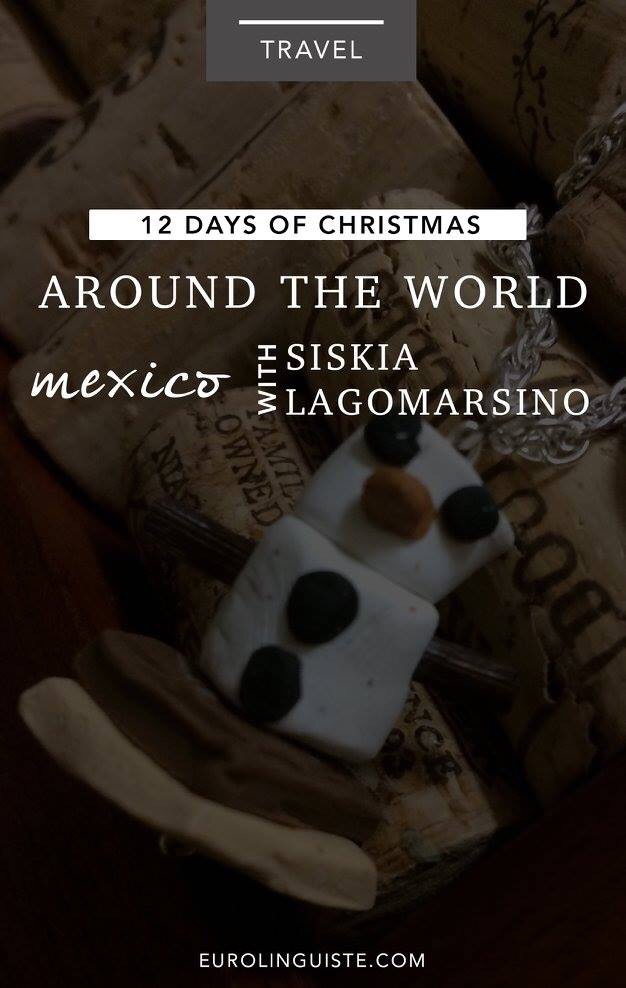Christmas in Mexico with Siskia Lagomarsino | 12 Days of Christmas Around the World Day 6

My name is Shannon Kennedy and I'm the language lover,…
About the Author // Siskia Lagomarsino is a translator and language tutor currently based in Mexico. She is a native English and Spanish speaker who discovered her passion for language learning when she began studying Japanese at the age of 20.
Christmas in Mexico with Siskia Lagomarsino
The way in which Mexicans celebrate Christmas almost always comes as a shock to visitors to this country; although in recent years it has come to closely match the more global, bearded-Santa-and-reindeers theme that we all associate with Christmas, many uniquely Mexican features of Navidad still remain.
Now, when I say “Mexican”, I actually mean “from all over the place”. It may not seem like it, but Mexico’s culture is built on layer upon layer of syncretic creeds and celebrations: believe it or not, living in the midst of this huge cultural hodge-podge makes for some really lively ‘fiestas‘!
But what is ‘Navidad‘ in Mexico, anyway?
If you know a little about how the country now known as Mexico came to be, you may know that before the Spaniards came, there were many tribes there, a lot of which were ruled at one point by a particular tribe called the Mexica (wrongfully known to the world as the Aztecs). The Mexica worshipped many gods, but one could say that their go-to gods were Tlaloc (god of rain) and Huitzilopochtli (god of war and sun).
As it were, Huitzilopochtli was so important to the Mexica that the whole equivalent of a month, called Panquetzaliztli (which roughly runs from December 7 to December 26) was dedicated to him. The Mexica celebrated by decorating their houses, doing sports, dancing, singing, praying… and doing human sacrifices at the end! (Huitzilopochtli was something of a blood-thirsty fellow.)
Obviously, after the Conquest, the Catholic Spanish rulers would have nothing of this, but while spreading the faith they’d already encountered pretty serious resistance from the natives who refused to give up their traditions just like that, so rather than push a whole different creed on the new Mexicans, they took advantage of the fact that their former chief god’s festivities were so close to the traditional Christmas, slipped the Spanish narrative and imagery of Christmas little by little on the native narrative as part of their ultimately successful evangelization campaigns, and ‘la Navidad mexicana‘ was born!
How was Christmas in Mexico celebrated traditionally?
Christmas in Mexico used to be a loooong, colorful engagement, and in some villages it still remains so. One of the oldest Christmas celebrations was the traditional ‘posada‘, originally a Spanish tradition: it is a kind of theatrical procession (and prelude to part-ay!) that involved the local community choosing two people, a Mary and a Joseph, to represent their looking for lodging before Jesus is born, going from home to home until a generous samaritan (also a house picked prior to the posada) allows them to stay; after this, more traditional towns continue the act into an ellaborate offering to a baby Jesus figurine, chanting and praying, but in the larger cities, the host house is usually just meant to gather the community in celebration, clink a glass of Christmas punch or apple wine, and have a neighborly laugh before Christmas Eve, which is more of a family affair. (In a nutshell, it’s a great excuse to get drunk.)
I mentioned the baby Jesus figurine because it’s a very unique trait of Mexican holiday culture: extremely Catholic families all have one (the oldest ones are made of china), and spend sometimes exorbitant amounts of money dressing them up in order to have them ‘spend their birthday’ in style. (As you may imagine, there are even shops where they sell clothes exclusively for these figurines. Google ‘se visten niños Dios‘ sometime—you’ll either have a good laugh or get thoroughly creeped out, depending on what you think of dolls.) Another family tradition related to the image of baby Jesus is the laying of the ‘Nacimiento‘ or nativity scenes, which are miniature scenes of the birth of Jesus usually placed at the feet of the Christmas tree.
Piñatas also appear a lot during the Christmas holidays, typically during the posadas. Although these colorful contraptions, traditionally filled with winter fruit such as sugar cane, guava and tangerines (although nowadays, it’s easier to just put candy in them) are associated with Mexico, the tradition actually came from China (!) via Italy and then Spain.
How do we celebrate Christmas in Mexico nowadays?
The bigger Mexican cities largely resemble the US during the holidays—there’s a frenetic rush of gift-buying, worrying over your kids’ letter to Santa, and wondering how to give a secret Santa gift that won’t make you the joke of the year. Children either will go to bed early or not at all on the 24th, and adults will have worried grimaces just by thinking of getting on the scales.
There is, however, one fundamental difference: in Mexico, it’s a tradition to eat a stuffed turkey on Christmas rather than Thanksgiving. Other delicious traditional Christmas foods are “romeritos”, a stew of romerito sprigs (related to rosemary) cooked with mole sauce and shrimp patties, and “bacalao a la Vizcaina”, a Spanish stew of salted cod fish cooked in tomato sauce and garnished with the spicy chile guero. (Incidentally, both of these are iconic Christmas foods, but they’re also so complex and time demanding that most people don’t actually prepare them themselves, but rather they order them from businesses who do.)
VOCABULARY/SENTENCES
| Spanish | English |
| ¡Feliz Navidad! | Merry Christmas |
| ¡… y un próspero año nuevo! | And a happy new year; answer to #1 |
| El árbol de navidad | the Christmas tree |
| Corona de navidad | Christmas wreathe or garland |
| Posada | a 9 day Christmas festival dramatizing the journey of Mary and Joseph |
| Pastorela | another type of ‘birth of Jesus’ play, similar to the Posada but acted on a stage |
| Nochebuena | Christmas Eve; also a name for poinsettias, the most popular flower in Mexico during these holidays |
| Piñata | pinata |
| Villancicos | Christmas carols |
| Nacimiento | Nativity scene |
| Niño Dios | baby Jesus |
| Ponche | Xmas punch—made from seasonal fruits, brown sugar, and cinnamon |
| Tamales | tamales |
| Romeritos | a Mexican dish containing seepweed |
| Pavo | turkey |
| Regalos | gifts |
| El puente Guadalupe-Reyes | the long holiday season that spans from the Día de la Guadalupe, the birthday of Mexico’s patroness virgin, on December 12, to the Día de Reyes, on January 6, and includes Christmas) |

Bacalao a La Mexicana
Notes
1 chile, ancho (optional)
1 lb tomatoes
1/4 cup olive oil
1/2 large onion, finely chopped
2 garlic cloves, finely chopped
1 bay leaf
1 pinch ground cinnamon
1 pinch fresh ground pepper
1/2 (220 g) jars roasted red peppers
1/4 cup sliced blanched almond
1/2 cup pimento stuffed olive
2 tablespoons chopped parsley
1 large potato, cooked and peeled
salt to taste Soak the cod in cold water for 12 hours, changing the water at least 2 or 3 times.
Drain and place the cod in a saucepan with water. Bring to a boil Drain, remove any unwanyed parts of the fish and set aside.
Soak the chile ancho in hot water for about 10 minutes, then drain and puree the chile in a blender along with the tomatoes. Strain mixture.
Heat the oil in a large skillet, add the onion and garlic. Cook over low heat until transparent. Add in the chile/tomato puree and continue to cook over low heat until mixture thickens. Add in the cod, bay leaf, cinnamon, pepper, red peppers, almonds, olives, capers and parsley. Stir mixture and then cook covered over medium heat for approximately 15 minutes. Add the potatoes, cover and cook over high heat for 10 more minutes to heat through. Add salt if required.
Garnish with chiles gueros. Serve warm. Adapted from Food.com
Would you like to download a copy of this recipe and vocabulary? Enter your email below and I’ll send you the password and link to the page on this site where all 12 of the recipes and vocabulary sheets will be posted!

My name is Shannon Kennedy and I'm the language lover, traveler, and foodie behind Eurolinguiste. I'm also the Head Coach of the Fluent in 3 Months Bootcamp, co-founder of Women in Language, and former Resident Polyglot at Drops.



